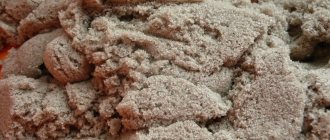Many doctors answer positively the question of whether it is possible to take activated charcoal while breastfeeding (BF). This is a relatively safe remedy that removes toxins from the body during food poisoning, viral and bacterial infections.
During lactation, mothers of infants should be very careful about taking various medications, given their penetration into breast milk and potential harm to the baby. Activated carbon is a natural adsorbent and works only in the intestines: toxins accumulate on its surface and are then removed from the body. But this does not mean that the drug can be taken in any quantity: it is important to maintain the correct dosage so as not to upset the balance of nutrients in the body and not harm the baby.
Release form, features of the drug
Activated carbon comes in white and black colors. Black activated carbon has a pronounced absorbent effect, while white activated carbon is aimed at removing vitamins from the body.
White activated carbon
It is used as the main component of dietary nutrition for weight loss and is prohibited during breastfeeding.
Black activated carbon
Approved for use by nursing women. It has a neutral taste and is odorless. Available in tablet form, it has a distinct black color.
White coal during breastfeeding
White coal is a modern enterosorbent, which, like Activated carbon, is widely used for poisoning, indigestion and flatulence.
Various forms of White Coal release
White coal contains:
- silica;
- microcrystalline cellulose;
- excipients: powdered sugar;
- potato starch.
It is recommended to use White Coal as a biologically active food supplement (BAA) to improve the functional state of the gastrointestinal tract. The list of indications for Activated and White carbon is the same. Let's look at the main differences between the drugs.
Table: differences between Activated and White carbon
| Activated carbon | White coal |
| Applicable without age restrictions. Even for infants, pregnant and lactating women | Contraindicated in pregnant women, lactating women and children under 3 years of age |
| A well-known and proven drug over the years, it enjoys well-deserved respect. | New |
| Long-term use may cause constipation | It does not cause constipation, it removes poisons and toxins from the body more effectively and quickly. |
| Successfully copes with long-term diarrhea | Does not help with prolonged diarrhea, which is often observed with poisoning |
| Acts a little slower in acute gastrointestinal colic | It is more effective in acute gastrointestinal colic and increased gas formation and flatulence. |
White coal is contraindicated during pregnancy and breastfeeding.
Properties of activated carbon
The main and most important function of activated carbon is to absorb and remove harmful and dangerous toxins from the body. It is not absorbed into the blood and is not found in breast milk.
Activated carbon is prescribed to a nursing mother in the following cases:
- food poisoning;
- flatulence, increased gas formation;
- intestinal infections;
- for allergic reactions;
- psoriasis;
- preparation for x-ray examinations.
This drug has the ability to neutralize food toxins, allergens, and break down gas bubbles in the intestines.
What does activated carbon help with?
The use of the drug is recommended for intoxication of the body. In case of poisoning, activated carbon is able to absorb toxic molecules and remove them out. Tablets are recommended for use for gastrointestinal infections, disorders, and allergic reactions. During lactation, the antidote is best taken within several hours after the first signs of the disease. In addition, the main indications for use include:
- digestive system problems;
- dysbacteriosis;
- high level of gas formation;
- kidney failure;
- hepatitis;
- rapid formation of gastric juice;
- dysentery;
- intestinal infections;
- cirrhosis of the liver.
For allergies
Treatment of acute allergic reactions with activated carbon has been practiced for many years. Therapy for lactation takes a long period, but is very effective and completely safe for health. If you do not know how often you can take the drug, then proceed according to this scheme:
- Calculate your dose according to your body weight. The tablets must be taken at a time with plenty of water. If this is difficult to do, the drug can be crushed to a powder and mixed with liquid, and then drunk.
- You can take the absorbent at any convenient time, but it is better to do it in the morning on an empty stomach. If you are taking other medications, make sure that there is at least a 2-hour gap between the time you take them and the time you take the charcoal. Otherwise, the effect of the latter will come to naught.
- Treatment must be continued for 14 days. In rare cases, your doctor may recommend taking the drug for up to 45 days.
- Courses of treatment can be repeated after 2-3 months. In the intervals between therapy, care must be taken to ensure that the body replenishes its reserves of vitamins. This is especially true for pregnant and lactating women. If a woman is allergic to flowering, then the course is carried out in late April and early August.
Diarrhea in a nursing mother
The cause of the disorder may be unwashed hands or poorly processed foods, through which the infection penetrates into the body. During illness, germs are not transmitted to the baby, but this causes many unpleasant moments for the mother. It is best to act during lactation after consulting a doctor. The intensity of therapy will depend on its diagnosis.
Article on the topic: Pain in the joints of the fingers when bending
Activated carbon is considered the very first and safest antidote that can solve the problem. The sorbent will collect all harmful substances and remove them out. The drug does not affect the composition of milk at all during breastfeeding, so you should not stop feeding your child. If there is no such remedy, then you can use analogues. The course of treatment depends on the complexity of the situation and can last several days.
Poisoning during breastfeeding
Treating women for the disorder during breastfeeding and pregnancy has a number of challenges that involve limiting chemicals. At this time, only a doctor should prescribe medications, otherwise elements harmful to the baby may get into the milk. Food poisoning is one of the common problems that worries expectant mothers. Treating the disorder with antibiotics is strictly prohibited. Activated carbon during lactation is a safe antidote that will help get rid of the disorder. The disease can be identified by the following signs:
- stomach upset;
- constipation;
- vomit;
- stomach ache;
- weakness.
For effective treatment, a girl who continues to breastfeed needs:
- Avoid foods that cause food poisoning.
- Take a dose of absorbent. During lactation, it will help the body remove all harmful elements out. The antidote should be taken several hours before or after meals.
- It is necessary to drink as much alkaline mineral water as possible.
- You need to switch to a gentle diet that will not affect the mucous membrane.
Dosage and rules of administration
The dosage of the drug depends on the reason that necessitated the need to take activated carbon, as well as the severity of the disease.
- Poisoning. For poisoning, the recommended dose is 1 tablet per 10 kg of weight.
- Flatulence. For bloating, the dosage is 1 tablet per 30 kg of weight.
- Psoriasis. Dosage: 1 tablet per kilogram of weight. The total amount of the drug is divided into 2 doses - morning and evening.
The total daily dose, in any case, should not exceed 10 tablets. The maximum course of treatment with activated carbon is 2 weeks. The tablets must be taken with plenty of water.
When taking this drug, it should be borne in mind that it neutralizes and removes not only toxins from the body, but also nutrients, as well as medications. Therefore, it is necessary to take activated charcoal 40 minutes before or 2 hours after meals and other medications.
Rules of admission, instructions for use
Materials of organic origin are used as raw materials for the production of Activated Carbon. This:
- wood;
- coal;
- bituminous coal;
- coconut shells.
Organic materials for the production of Activated Carbon
To obtain Activated Carbon, these materials undergo several stages of processing:
- Carbonization is the process of firing (heat treatment) of raw materials in airless inert conditions using high temperature. After carbonization, the result is carbonizate, which is coal that has very insignificant adsorption qualities due to the small internal area and small dimensions. The carbonate is subject to crushing and activation in order to achieve a special structure of the substance and a significant increase in adsorption.
- Crushing is the grinding of activated carbon obtained after carbonization. Its initial dimensions are 30–150 millimeters, and effective activation of the adsorbent is difficult due to such large fractions. Therefore, the carbonate is thoroughly crushed to fraction sizes of 4–10 millimeters.
- Activation. There are two activation methods: chemical and steam-gas. Chemical activation for the production of activated carbon is the treatment of a substance with salts, which release an activating gas when exposed to high temperature. The activator can be nitrates, sulfates, carbonates, sulfuric, phosphoric or nitric acid. The production of activated carbon using this method is carried out at a temperature of 200 - 650o C;
- Vapor-gas activation is carried out exclusively under strictly controlled conditions, at temperatures from 800 to 1000 o C. At the time of vapor-gas activation of coal, water vapor and carbon dioxide act as oxidizing agents. The interaction of steam with carbon is accelerated by oxides and carbonates of alkali metals. Given this fact, they are periodically added in small doses to the source material. Copper compounds are also used as a catalyst. The production of active carbon from carbonizate using the steam-gas technique makes it possible to obtain a powerful adsorbent with a surface area of maximum 1500 m2 per gram of coal. True, not the entire area can be used for absorption, because large molecules of the adsorbed substance will not enter the small pores.
Use of horizontal rotary kiln in Activated Carbon Plant
Today the scope of the drug is very wide. Activated carbon is used not only in medicine, but also in the chemical, pharmaceutical and food industries. Thanks to the adsorption properties of coal, it has become possible to quickly and effectively purify wastewater and exhaust gases. Activated carbon is often used to purify radioactive gases and water in nuclear power plants.
Activated carbon is widely used in medicine, as well as in the chemical, pharmaceutical and food industries.
Our grandmothers also used activated carbon as an effective remedy for poisoning and flatulence.
It is recommended to take Activated Carbon, like all sorbents, 1–1.5 hours before or after meals or medications. The effect after taking the medicine will be noticeable within 25–30 minutes.
Activated carbon dosage
Therapeutic dose of the drug:
- in severe cases at the rate of 1 tablet per 10 kg of body weight;
- in all other cases, regardless of weight, 1–2 tablets.
Table: dosage of the drug depending on age and disease
| Age | Disease | Dosage | |
| Adults | For flatulence and dyspepsia | 0.25–0.75 g (1–3 tablets) 3–4 times a day | |
| With increased acidity | 1–2 g (4–8 tablets) 3–4 times a day | ||
| In case of poisoning and intoxication | 20–30 g per dose in the form of an aqueous suspension in 0.5–2 glasses of water | ||
| Children | from 7 to 14 years | In case of poisoning | 7 g 3 times a day in the form of a suspension of crushed tablets in a small amount of water, wash down with a glass of water |
| from 3 to 7 years | In case of poisoning | 5 g 3 times a day in the form of a suspension of crushed tablets in a small amount of water, wash down with a glass of water | |
| up to 3 years | The tableted drug is not prescribed. Use only as a suspension | ||
The duration of treatment is determined by the doctor. Sometimes a few doses of the drug are enough, but more often treatment is carried out over a course of 3–7 days, with a maximum of 10 days.
Like any medicine, breastfeeding women take activated carbon only as directed and under the supervision of a doctor.
Breastfeeding women should pay attention to the following when taking Activated Carbon:
- The tablet should be taken immediately after feeding. After taking the pill, you should not feed your baby for at least 2-3 hours.
- The maximum dosage should not exceed 10 tablets of 0.25 g per day. The number of tablets is calculated depending on weight: for 10 kg - 1 tablet of 0.25 g.
- The tablets should be consumed in the form of an aqueous suspension, that is, the tablets are crushed and diluted with water at the rate of 0.5 liters of water per 20–30 grams of powder.
Contraindicated for whom
Despite its apparent safety, activated charcoal has contraindications during breastfeeding, like any drug. Its use is prohibited in the following cases:
- stomach and duodenal ulcers;
- stomach bleeding;
- daily medication intake due to chronic diseases;
- intestinal atony.
By absorbing beneficial substances, activated carbon significantly reduces their beneficial effect on the body. Therefore, medications taken along with this drug, or shortly before taking it, will be regarded by it as harmful, neutralized and removed from the body. Thus, the desired effect of treatment will not be achieved.
Despite the relative harmlessness of activated carbon, the decision about whether it is necessary and possible to use during breastfeeding in a particular situation must be made by a physician. After all, there are restrictions on the use of this substance.
Analogs of activated carbon for use by nursing mothers
If the use of activated carbon for a woman while breastfeeding is not suitable, the drug can be replaced with several analogues:
- Smecta or Neosmectin are preparations of mineral origin, often prescribed for diarrhea. They have a binding effect, normalize the level of acidity in the stomach and are allowed for mothers during breastfeeding;
- Enterosgel is a product that does not interfere with the absorption of beneficial substances in the intestinal tissues, but effectively removes toxins and waste from the body. Allowed for use by children, pregnant and lactating women;
- Polypefan and Filtrum STI are analogs of activated carbon that have similar indications and contraindications (if the dose is exceeded, they also cause constipation).
Important! The selection of a drug suitable for a woman breastfeeding should be carried out by a specialist. The doctor will take into account all existing diseases, contraindications, evaluate possible side effects and offer the optimal solution.
Activated charcoal, if a breastfeeding mother uses it correctly, can be a salvation for diarrhea, bloating, colic and symptoms of poor-quality food poisoning. The drug is considered harmless to the baby, which is also important for a nursing woman. However, like any medicine, charcoal has its own contraindications that must be taken into account before starting use. To prevent the development of unexpected reactions, it is better to consult a doctor and, together with a specialist, choose the appropriate remedy in a particular case.
Adverse reactions
Yes, activated carbon also has a number of side effects. Here are some of them:
- Unreasonable and frequent use of the drug leads to leaching of useful substances from the body. This contributes to a decrease in the nutritional level of breast milk.
- There is a violation of the absorption of proteins and fats.
- In rare cases, it can have the opposite effect in the treatment of diarrhea and bloating, and serve not as a fixative, but as a laxative.
- With prolonged use it causes constipation.
- When taken in large doses, it can cause a decrease in blood pressure.
When used correctly and overdose is avoided, the development of side effects is unlikely. Therefore, it is important to follow the rules for taking the drug.
Losing weight with activated carbon
We have sorted out the question of whether activated carbon can be used for nursing mothers. But many women who have gained weight during pregnancy are concerned about another question. It consists of the following: can a nursing mother use activated carbon as a drug for weight loss? Let's figure it out.
The course of weight loss based on taking this drug is 12 days. During this period, it is forbidden to consume sweets, alcohol, fatty foods, and flour. In addition, the diet involves following a diet that includes a set of certain dishes.
As we know, a nursing mother needs good nutrition so that her baby receives all vital substances and microelements with milk. Activated carbon interferes with the absorption of many vitamins and negatively affects the nutritional value of milk.
Think about what is more important to you – the health of your child, or your appearance? You can get in shape in another way. For this purpose, there are specially designed effective sets of physical exercises.
Other forms of absorbent
Activated charcoal should be used during breastfeeding after consultation with your doctor. He will select the most effective dosage and give recommendations for use.
In addition to the usual black tablet form of this drug, there are also more modern analogues. The most famous of them are Smecta and Polysorb PM.
These products have a milder effect and are approved for use by children. Therefore, they can also be drunk by nursing mothers, following the recommended dosages. However, the main effect of these drugs is similar to the action of activated carbon - neutralization and removal of toxins.
The main differences between these drugs are their taste. If activated carbon has a neutral taste, then Smecta is softer and slightly sweeter. Polysorb, when preparing a suspension, does not dissolve in water and is a suspension with a very specific taste.
All drugs in this group are approved for use during breastfeeding.
Analogs
Experts are ambivalent about the use of activated carbon for newborns with the development of colic, flatulence, and allergic reactions. If previously it was given from the first days of life, now it is recommended to take it only after reaching the age of three. In the pharmacy chain you can find safer and more modern intestinal adsorbents suitable for infants and nursing mothers:
- Smecta . It is used for acute and chronic intestinal infections, various poisonings, and gastrointestinal disorders.
- Enterosgel . Also considered safe for breastfeeding women. The drug successfully removes toxins regardless of their origin. However, it does not affect the functioning of the intestines and does not interfere with the absorption of beneficial elements, which cannot be said about treatment with activated carbon.
- Atoxyl . Another product that belongs to enterosorbents. This medicine is used during breastfeeding for acute intestinal diseases accompanied by diarrhea syndrome, as well as in the complex treatment of liver pathologies.
- Polysorb . Indicated for symptoms of poisoning, intoxication, toxicosis, allergic manifestations, gastrointestinal disorders. It is superior in efficiency to many analogues. The dosage of the drug is calculated depending on the pathological condition after consulting a doctor.
When breastfeeding for a baby, charcoal remains a safe and acceptable remedy that does not in any way affect its condition. If you need to use a sorbent, you should not refuse it, hoping that the body itself will be able to cope with the problem. Although many reviews indicate that most women prefer to be treated with modern drugs, Activated carbon remains an equally popular and effective time-tested remedy.
( 1 ratings, average: 5.00 out of 5)
Useful absorbent
We think you have no doubts about whether activated carbon is suitable for nursing mothers. Now you know that this drug is not absorbed into the blood and does not pass to the baby through breast milk. But at the same time, you must follow the rules for taking it.
- The maximum daily dose for a nursing woman is 10 tablets.
- Duration of use is no more than 2 weeks.
- You need to take the drug with plenty of water.
- Taking the medicine must be justified and agreed with the doctor.
- You should not take activated charcoal unless necessary - this can cause side effects.
- You should drink activated charcoal 40 minutes before or 2 hours after taking other medications and food.
Dosage during lactation
The dosage of activated carbon preparations during breastfeeding of a baby depends on the severity of the pathology identified in the nursing mother and on its clinical manifestations:
- In order to get rid of flatulence and the feeling of bloating, one tablet (weighing 0.25 g) of activated carbon for every thirty kilograms of body weight is enough. In this case, the drug can be taken once or two or three times during the day.
- In the presence of dyspeptic disorders, characterized by painful and difficult digestion, the frequency of taking activated carbon is three to four times a day. The duration of the course of treatment, as a rule, is no more than five days.
- When treating all types of mild poisoning, it is necessary to increase the dosage of the sorbent, taking one tablet for every ten kilograms of live weight. For example, if a nursing woman weighs 50 kg, she needs to take five tablets at a time, thoroughly crushed into powder and diluted with boiled water (taking the drug in the form of an aqueous suspension greatly facilitates this process). The recommended daily dose of activated carbon should not exceed ten tablets, and the duration of the therapeutic course cannot be more than two weeks.
- The permissible daily dose of sorbent during the treatment of acute poisoning is 8 g (or 32 standard tablets). In the most severe cases, a nursing mother may be advised to take a loading dose of the sorbent, when she needs to urgently take 30 g (or 120 tablets) at a time. After this, qualified infectious disease specialists advise stopping breastfeeding the baby until the mother’s body is completely cleansed of toxic substances.
- Treatment of allergic diseases is long-term and takes at least 14 days.
- In case of poisoning with drugs or chemicals, activated carbon can be used to lavage the stomach. One tablespoon of tablets, ground into powder, is mixed with 1000 ml of boiled water. The patient should take the resulting suspension in 100-200 ml doses. Activated carbon preparations have the maximum positive effect during the first twelve hours after poisoning. If it is not possible to cope with the clinical manifestations of poisoning within 48 hours, the nursing mother should definitely see an experienced infectious disease specialist.
All of the above recommendations are only general in nature, since only the treating specialist should prescribe exact dosages in each specific case.
If it is necessary to take sorbents for a long time, the doctor may prescribe white coal to a nursing mother - a medicine that is an analogue of activated carbon and has a number of important advantages.
Unlike its black counterpart, it is endowed with selective sorption activity, allowing it to absorb and remove only toxic substances from the body.











